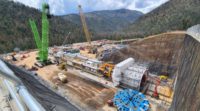The market on May 8 welcomed an initial public offering by Parsons Corp.—detailed in an April 29 U.S. Securities and Exchange Commission filing—snapping up 10.9 million shares by mid-morning, pushing the stock price up to $30.28, well above the opening bell price of $27.
The company planned to offer 18.5 million shares to the marketplace in a transaction valued at $500 million. The company valuation was listed at $ 3.2 billion.
Uber's highly publicized IPO, executed on May 9, was valued at $8.1 billion, below a $10.4 billion figure that had been touted, cautious in the wake of rival Lyft's 20% share drop since its March public debut. Uber is still the largest IPO since 2014. The deals are just two of what analysts said was the IPO market’s most active week in the last four years, with at least 15 deals set.
Parsons stock has been owned since 1984 by its estimated 15,000 employees through an employee stock ownership plan. Industry sector market watchers are optimistic on the outcome for the firm. The IPO would offer about 20% of total shares.
"Parsons had been public from 1959 to 1964 ,,, and always thought we'd go public again some day. We've done a lot of growth though [mergers and acquisitions], and this has helped us continue that path," Chairman Charles Harrington said in a CNBC interview, noting that new "dry powder" gained in the IPO will fuel additional purchases.
It has been expanding U.S. government cybersecurity, intelligence and mission critical work, which observers say is a more stable and less risky arena. "When you're protecting the government's infrastructure and intelligence and missile defense, we think those are pretty secure parts of the defense spend," Harrington said.
The firm recently moved its headquarters to a Washington, D.C., suburb from Pasadena, Calif., to be closer to that client base.
Parsons, which lists its stock on the New York Stock Exchange under the symbol PSN, will use the cash to fuel growth and pay down an estimated $300-million debt.
In January, Parsons acquired OGSystems, a consultant specializing in geospatial intelligence, big data analytics and threat mitigation primarily for government agencies, the firm’s third purchase in that sector in 14 months.
Online financial site Benzinga cites Parsons’ total 2018 revenue at $3.56 billion, with its federal unit comprising 41.5% of that total and critical infrastructure 58.5%. The site says the former unit grew 37% last year, while the latter up just 7.5%. The firm also saw its backlog rise 24.1% year-over-year in 2018 to $8 billion.
Harrington said the firm could also gain in its work in complex airport and intelligent highway systems if new infrastructure spending is passed.
“As time goes on, the convergence of technology and ‘traditional’ engineering will continue to blur the lines of an engineering service provider,” says Michael O’Brien, partner at industry financial consultant Rusk O’Brien Gido. “With an aging demographic, repurchase obligations for closely-held companies have become a big concern for managing cash flow.”






Post a comment to this article
Report Abusive Comment